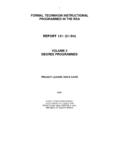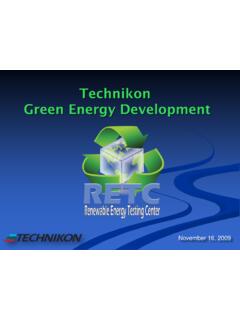Transcription of CERP Organic HAP Emission Measurements for Iron …
1 technikon 1412-317 NA JANUARY 2006 CRADA PROTECTED DOCUMENT i Casting Emission Reduction Program AMERICAN FOUNDRY SOCIETY, INC. US Army Contract W15 QKN-05-D-0030 FY2005 Tasks WBS # CERP Organic HAP Emission Measurements for Iron Foundries and Their Use in Development of an AFS HAP Guidance Document (First Publication AFS Paper 06-031) technikon # 1412-317 NA Revised for public distribution January 2006 & August 2007 Prepared by: technikon LLC 5301 Price Avenue McClellan, CA, 95652 (916) 929-8001 technikon 1412-317 NA JANUARY 2006 CRADA PROTECTED DOCUMENT ii this page intentionally left blank technikon 1412-317 NA JANUARY 2006 CRADA PROTECTED DOCUMENT iii CERP Organic HAP Emission Measurements for Iron Foundries and Their Use in Development of an AFS HAP Guidance Document (First Publication AFS Paper 06-031) George R. Crandell technikon LLC, McClellan, CA James F. Schifo KERAMIDA Environmental, Inc., Indianapolis, IN Gary Mosher American Foundry Society, Schaumburg, IL Copyright 2006 American Foundry Society technikon 1412-317 NA JANUARY 2006 CRADA PROTECTED DOCUMENT iv this page intentionally left blank technikon 1412-317 NA JANUARY 2006 CRADA PROTECTED DOCUMENT v Table of Contents Executive Summary.
2 1 INTRODUCTION AND BACKGROUND ..3 DISCUSSION ..5 METHODS OF ESTIMATING HAP Emission RATES .. 5 SOURCES OF HAP EMISSIONS IN TYPES OF HAP EMISSIONS ..8 Inorganic HAP 8 Organic HAP Emissions .. 8 Organic HAP Variability- General .. 10 Organic HAP Variability- Greensand Variability Study .. 10 Organic HAP Variability- Material Related Issues .. 13 HAP Emission TESTING RESULTS FOR IRON ..15 CERP TESTING METHODS AND SUMMARY ..23 List of Figures and Tables Figure 1 Source of Ferrous Foundry HAP Emissions ..7 Figure 2 CERP Benzene Emission Profile (Cored Greensand Mold)..10 Figure 3 CERP Variability Study, Variable Combustible Level (Seacoal) ..11 Figure 4 CERP Variability Study, Cubes with Constant Surface Area to Volume Ratio ..12 Figure 5 CERP Variability Study, Cubes, Spheres, Plates and Finned Plates with Constant Pour Weight ..12 Figure 6 CERP Variability Study, Variable Shakeout Time, Cored Greensand Figure 7 CERP PCS HAP for Greensand with Seacoal.
3 15 Figure 8 CERP PCS HAP Emissions from Seacoal Reduction or Replacement Products ..15 Figure 9 CERP PCS HAP Emissions for Molds Containing Phenolic Urethane Cores without Seacoal ..16 Figure 10 CERP PCS HAP Emissions for Molds Containing Misc. Cores Binders without Seacoal ..16 technikon 1412-317 NA JANUARY 2006 CRADA PROTECTED DOCUMENT vi Figure 11 CERP PCS, HAP Emissions for Molds Containing Cores with Seacoal ..16 Figure 12 CERP PCS, HAP Emissions for No-Bake Figure 13 CERP HAP Core / Mold Emissions (Sand Mixing, Making and Storage)..17 Figure 14 Other Greensand HAP Emissions Sources in Lbs. per Ton of Iron Poured ..17 Figure 15 Baseline Emission Profile PCS, Tests CY & CH, 2000 ..18 Figure 16 CERP Baseline Analyses PCS, Tests CY, CH & CE, 2000 ..19 Table 1 Sampling and Analytical Table 2 AFS Foundry Emission Factors for Preliminary Screening (2001)..25 Table 3 AFS 2005 Emission Factor Table ..26 Appendices Appendix A Acronyms and Abbreviations ..27 Appendix B technikon 1412-317 NA JANUARY 2006 CRADA PROTECTED DOCUMENT 1 Executive Summary Since the 1990 promulgation of Title III (Hazardous Air Pollutants or HAPs) of the Clean Air Act Amendments, many industry and regulatory initiatives have focused on identifying and quantifying ferrous foundry hazardous air pollutants.
4 The applicability of these regulations to individual facilities is determined by the facilities HAP Emission level. This paper summarizes the efforts of the American Foundry Society (AFS), research institutions, and individual foundries to identify and quantify HAP emissions from iron foundry sources. The objective was to supply the industry and regulators with HAP Emission guidance documents that can be utilized in determining a facilities HAP Emission inventory profile. technikon 1412-317 NA JANUARY 2006 CRADA PROTECTED DOCUMENT 2 this page intentionally left blank technikon 1412-317 NA JANUARY 2006 CRADA PROTECTED DOCUMENT 3 INTRODUCTION AND BACKGROUND Regulatory drivers in the form of the National Emission Standards for Hazardous Air Pollutants (NESHAPs) required under Title III of the 1990 Clean Air Act Amendments and state specific air toxic regulations, promulgated by many states, have resulted in a need to quantify HAP emissions.
5 These new and existing regulations will affect foundries in many ways. The NESHAP regulations, also known as the Maximum Achievable Control Technology (MACT) rules, require certain existing foundry operations to meet the HAP Emission limits based on the average of the top 12% of sources in the industry. This is based on both work practices and installed air pollution control equipment as appropriate. The MACT Emission limits can be achieved through the use of work practices and technology-based limits, which will require certain control equipment or process changes. MACT requirements will apply to Major Sources of HAPs, which are those facilities emitting 10 tons per year of an individual HAP, or 25 tons per year of all HAPs. This determination is made on a case-by-case basis by individual foundries, and is based on Potential to Emit (PTE). PTE is calculated using maximum permitted Emission rates, taking into consideration federally enforceable permit limitations and facility operational constraints.
6 Absent from any federally enforceable permit restrictions, a facility must determine its PTE based on maximum capacity for 8,760 hours per year. The future Residual Risk regulations under Title III will require evaluation of the risk remaining after implementing MACT level controls usually at least eight (8) years after the effective date of the MACT. Additionally, Area Source regulations have listed the metalcasting industry, that is, those facilities with less than 10 tons per year of an individual HAP, or 25 tons per year of all HAPs as their total HAP Emission inventory as area sources of HAPs that will also need to be regulated. The applicability of these regulations to an individual foundry will be determined by the foundry s PTE HAPs. Therefore, having accurate Emission rates to perform the PTE analysis is critical in determining the impact of the MACT regulation on an individual foundry. This paper provides an overview of the different iron foundry HAP Emission factors available to the metalcasting industry and discusses the variability of HAP emissions with respect to process parameters.
7 This paper also documents the research sources used to develop the AFS HAP technikon 1412-317 NA JANUARY 2006 CRADA PROTECTED DOCUMENT 4 Emission factor article publications of 2001 and 2005. Many of the Emission factors and variability studies provided in this paper were developed by the Casting Emission Reduction Program (CERP). This program has been in existence since 1994, and is funded by the Department of Defense. The CERP program s Steering Committee consists of the AFS, the Casting Industry Supplier Association (CISA), USCAR, and the Department of Defense. CERP meeting participants have included universities, foundries, suppliers, the United States Environmental Protection Agency (EPA), and the California Air Resources Board (CARB). The original AFS HAP Emission factor table, shown on Table 2 at the end of this paper, contains recommended HAP Emission rates for typical foundry processes, and was based on early worst-case Emission estimates.
8 The Emission table and accompanying instructions were made available in 2001 to foundries and EPA as a screening tool to be utilized by foundries in determining their HAP emissions. A conservative approach to performing a screening analysis was recommended, and the Emission factors stated in the table consisted of both Organic and inorganic HAPs for the listed process areas. The data sources used for these recommended Emission factors included the EPA MACT long form survey database, CISA, and many research tests performed at CERP for pouring, cooling, and shakeout emissions (PCS). The table was approved and published by the AFS 10-E Air Quality Committee. The screening analysis provided by AFS was appropriate as an initial approach at determining MACT applicability. However, a more accurate method was needed to better quantify HAP emissions for a wider range of processes.
9 Since the major sources of HAP emissions from foundries are Organic emissions from PCS, the new Emission table focuses primarily on PCS Organic HAP emissions. Input from foundry associations, suppliers, and individual foundries guided CERP testing to provide the more process specific testing needed to develop a better guidance document. Table 3 represents the new AFS HAP Emission factors incorporating newer Emission data for a variety foundry processes and binder systems. This guidance was approved by the AFS 10-E Air Quality Committee in September 2005, and is available on the AFS Web Site, , as Organic Hazardous Air Pollutant Air Emission Factors for Iron Foundries. The research data provided in the following discussions are the basis for 2005 AFS Emission factors publication. These discussions include specific process emissions, process variability, and the testing results of new products not yet widely used by production foundries.
10 The research reports providing the bases for this document are available at technikon 1412-317 NA JANUARY 2006 CRADA PROTECTED DOCUMENT 5 DISCUSSION METHODS OF ESTIMATING HAP Emission RATES Foundries currently utilize several different methods to estimate their HAP Emission rates including the following: Process Emission Factors o From Stack Testing o From Research Initiatives Mass Balances Engineering Estimates It is imperative that HAP Emission estimates be accurate and somewhat conservative. If they are too high, then capital spending and operating costs will be increased unnecessarily. If they are low, then at some future date, stack testing could show non-compliance, resulting in penalties, as well as, increased capital and operating costs. Mass Balance and Engineering Estimates are the last resort, when all other methods fail to provide representative Emission estimates. The problem with these approaches is pouring, cooling and shakeout air emissions are the result of thermal decomposition, and that is not completely related to binder or molding sand systems used in the process.














